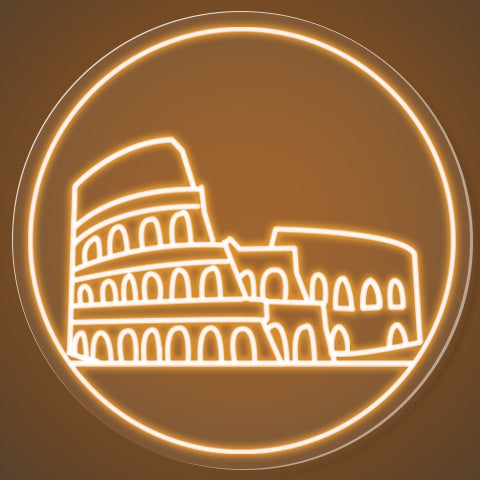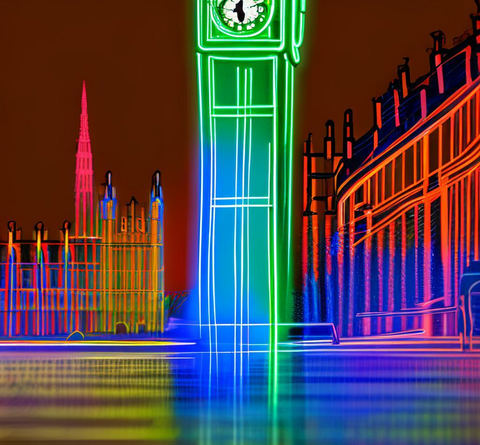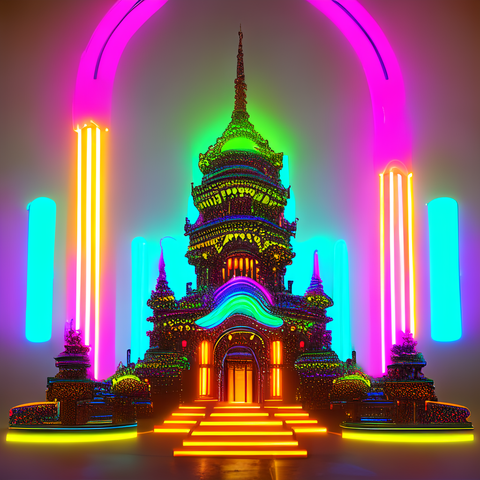Have you ever thought about what it would be like if some of the world's most famous landmarks were transformed into neon signs? While it might sound strange, the idea of iconic structures like the Eiffel Tower or the Taj Mahal as glowing, illuminated signs is not too far-fetched.
Neon signs have been a popular form of advertising and signage for decades and are often used to draw attention to businesses and events. So, what if some of the world's most famous landmarks were turned into neon signs?
Imagine driving down the highway and seeing the Great Wall of China as a neon sign or passing by the Colosseum and seeing it illuminated in vibrant colors. The Sydney Opera House or the Statue of Liberty as neon signs would be equally eye-catching.
1. The Great Wall of China
is one of the most iconic landmarks in the world and a symbol of the country's rich history and cultural heritage. Stretching over 13,000 miles across northern China, this ancient wall was built over more than 2,000 years to protect the country from invasions.

The Great Wall was originally constructed from a variety of materials, including earth, brick, and stone. Today, the wall is mostly made of brick and stone, and much of it has been renovated and restored. The Great Wall is so large that it is visible from space, making it one of the few man-made structures seen from orbit.
Visitors to the Great Wall of China can walk along sections of the wall, explore its many watchtowers and fortresses, and learn about its history and significance. The Great Wall is a UNESCO World Heritage site and a popular tourist destination, attracting millions of visitors each year.

Several sections of the Great Wall of China are open to tourists, including the Badaling section, which is the most popular and well-preserved, and the Mutianyu section, which is less crowded and offers a more rustic experience. No matter which section you visit, the Great Wall of China is a must-see destination.
2. The Pyramids of Giza
Some of the oldest and most famous landmarks in the world. Located on the outskirts of Cairo, Egypt, these ancient pyramids were built over 4,500 years ago as tombs for the Pharaohs and their queens.
The Pyramids of Giza consist of three main pyramids: the Great Pyramid of Giza, the Pyramid of Khafre, and the Pyramid of Menkaure. The Great Pyramid of Giza is the largest and most famous of the three and is considered one of the Seven Wonders of the Ancient World. It is also the oldest of the Seven Wonders and the only one that remains largely intact.

Visitors to the Pyramids of Giza can explore the pyramids and learn about their history and significance. The pyramids are also a popular spot for tourists to take photos and capture the beauty of the ancient structures.
In addition to the pyramids, the Pyramids of Giza site also includes the Sphinx, a giant limestone statue with a lion’s body and a human’s head. The Sphinx is considered a guardian of the pyramids and is another popular tourist attraction at the site.

The Pyramids of Giza are a UNESCO World Heritage site and a testament to the ingenuity and architectural achievements of the ancient Egyptians. They are a must-see destination for anyone interested in history and archaeology.
3. The Taj Mahal
is a mausoleum located in Agra, India, and is one of the country's most iconic landmarks. Built in the 17th century by the Mughal Emperor Shah Jahan as a tribute to his wife, the Taj Mahal is a symbol of love and one of the most famous examples of Mughal architecture.
The Taj Mahal is made of white marble and adorned with intricate carvings and inlaid with precious stones. It is a UNESCO World Heritage site and a popular tourist destination, attracting millions of visitors each year.

In addition to the Taj Mahal, the site also includes gardens, a mosque, and other buildings. Visitors to the Taj Mahal can explore the mausoleum and learn about its history and significance. The Taj Mahal is also a popular spot for tourists to take photos and capture the beauty of the building.

The Taj Mahal is not only a symbol of love and a masterpiece of architecture, but it is also a testament to India’s the rich history and cultural heritage.
4. The Eiffel Tower
is an iconic landmark in Paris, France, and is one of the most recognizable structures in the world. Built in 1889, the Eiffel Tower was originally intended as a temporary exhibit for the 1889 World's Fair, but it quickly became a symbol of the city and a popular tourist destination.
The Eiffel Tower stands over 1,000 feet tall and is made of iron. It is adorned with over 20,000 light bulbs that are illuminated at night, making it a beautiful sight to see. Visitors to the Eiffel Tower can take an elevator or climb the stairs to the top, where they can enjoy panoramic views of the city.

In addition to its stunning views, the Eiffel Tower is also a popular spot for tourists to take photos and capture the beauty of the city. It is a UNESCO World Heritage site and a must-see destination for anyone visiting Paris.

The Eiffel Tower is not only an iconic landmark and a symbol of the city, but it is also a testament to the ingenuity and engineering achievements of the late 19th century.
5. The Colosseum
is an ancient amphitheater located in Rome, Italy, and is one of the most iconic landmarks in the world. Built in the 1st century AD, the Colosseum was originally used for gladiator games and other public spectacles. It is a symbol of the city and a popular tourist destination, attracting millions of visitors each year.

The Colosseum is an engineering marvel and is one of the largest amphitheaters in the world. It is made of concrete and stone and is adorned with arches and pillars. Visitors to the Colosseum can explore the interior of the amphitheater and learn about its history and significance. The Colosseum is also a popular spot for tourists to take photos and capture the beauty of the ancient structure.

In addition to its historical and architectural significance, the Colosseum is also a UNESCO World Heritage site and a testament to the cultural achievements of the ancient Romans. It is a must-see destination for anyone interested in history and archaeology.
The Colosseum is not only an iconic landmark and a symbol of the city, but it is also a reminder of the rich history and cultural heritage of Rome.
6. The Sydney Opera
House is an iconic landmark located in Sydney, Australia, and is one of the most recognizable buildings in the world. Built in the 1970s, the Sydney Opera House is a symbol of the city and a popular tourist destination, attracting millions of visitors each year.
The Sydney Opera House is a masterpiece of modern architecture and is made of concrete, steel, and glass. It is adorned with distinctive white "sails" that are illuminated at night, making it a beautiful sight to see. Visitors to the Sydney Opera House can take a tour of the building and learn about its history and significance. The Sydney Opera House is also a popular spot for tourists to take photos and capture the beauty of the building.

In addition to its historical and architectural significance, the Sydney Opera House is also a world-class performing arts venue and hosts a variety of concerts, plays, and other events. It is a UNESCO World Heritage site and a testament to the cultural achievements of Australia.

The Sydney Opera House is not only an iconic landmark and a symbol of the city, but it is also a reminder of the rich culture and artistic achievements of Australia.
7. The Big Ben
is the nickname for the Great Bell of the clock at the north end of the Palace of Westminster in London, and is usually extended to refer to the clock and the clock tower as well. The tower stands 316 feet (96 meters) tall and has become one of the most iconic landmarks in London, as well as the United Kingdom as a whole.
The Great Clock of Westminster, as it was originally known, was designed by architect Augustus Pugin and built between 1843 and 1859. The clock was designed to be accurate to within one second per day, and it has remained one of the most reliable clocks in the world since its construction.

The Great Bell, or Big Ben, is the largest four-faced chiming clock in the world and is located at the top of the clock tower. The bell weighs over 13 tons (13,760 kg) and was named after Sir Benjamin Hall, who oversaw its installation. The bell is struck every hour, and the chimes of Big Ben are a familiar sound to many people around the world.

Big Ben has undergone several renovations over the years, with the most recent one occurring in 2017. The clock tower was closed for several years for renovations, and the clock itself was stopped for some time. However, the clock and tower have now been fully restored and are once again a fully functioning and iconic part of the London skyline.
In addition to being a popular tourist attraction, Big Ben is also a symbol of the United Kingdom and its parliamentary democracy. It is often featured in media and has become a symbol of London and the UK as a whole.
8. The Redeemer statue
is a massive artwork located in Rio de Janeiro, Brazil? The statue, which depicts Jesus Christ with outstretched arms, stands tall atop the Corcovado Mountain in the Tijuca Forest National Park, overlooking the city of Rio de Janeiro.
The idea for the statue was first proposed in the 1850s, but it wasn't until 1922 that the construction of the statue began. The statue was designed by Brazilian engineer Heitor da Silva Costa and created by French sculptor Paul Landowski. It was completed in 1931 and was officially inaugurated on October 12 of that year.

The Christ the Redeemer statue is made of reinforced concrete and is covered in soapstone, a soft, pliable stone that is easy to carve but also resistant to weathering. The statue stands at the height of 98 feet (30 meters) and weighs over 700 tons. It is one of the most iconic landmarks in Brazil and is considered an important cultural symbol for the country.
The statue is accessible by a series of ramps and stairs, and visitors can take a train or bus to the base of the mountain and then walk up to the statue. From the top of the mountain, visitors can enjoy stunning city views and the surrounding landscape.

In addition to being a popular tourist attraction, the Christ the Redeemer statue is also an important religious site for Catholics in Brazil. Many people make pilgrimages to the statue to pray and pay their respects. The statue has also become a symbol of hope and redemption for people around the world.
9. The Statue of Liberty
is a world-famous monument located in New York City, United States? The statue, which was a gift from the people of France to the people of the United States, stands tall on Liberty Island in New York Harbor and has become an iconic symbol of freedom and democracy for people around the world.
The statue was designed by French sculptor Frédéric Auguste Bartholdi and was completed in 1884. It was then disassembled and shipped to the United States, where it was reassembled on Liberty Island. The statue was officially dedicated on October 28, 1886.


The Statue of Liberty is made of copper and is sheathed in a thin layer of gold-colored copper. It stands at a height of 305 feet (93 meters) from the base of the pedestal to the top of the torch, and it weighs over 450 tons. The statue is designed to withstand strong winds and earthquakes, and it has stood tall for over 130 years as a symbol of hope and freedom for people around the world.
Visitors to the Statue of Liberty can take a ferry to Liberty Island and explore the grounds, as well as the pedestal and the base of the statue. There is also a museum on the island that tells the story of the statue and its significance.
10. The Great Mosque of Mecca
also known as the Masjid al-Haram, is the largest mosque in the world and is located in the city of Mecca, Saudi Arabia. The mosque is the holiest site in Islam, as it is the birthplace of the prophet Muhammad and the location of the Kaaba, a large black cube that is considered the most sacred site in Islam.
The Great Mosque of Mecca has undergone numerous expansions and renovations over the years, with the most recent expansion being completed in 2020. The mosque now covers an area of over 356 acres (144 hectares) and can accommodate over 2.5 million worshippers at any given time.

The Great Mosque of Mecca is an important site for Muslims all over the world, as it is the destination of the annual Hajj pilgrimage, which is one of the Five Pillars of Islam. The Hajj is a mandatory religious duty for all able-bodied Muslims, and it attracts millions of worshippers from around the world each year.

In addition to being a place of worship, the Great Mosque of Mecca is also a popular tourist attraction. Visitors to the mosque can explore the grounds, visit the Kaaba, and participate in the various rituals and ceremonies that take place at the mosque.
While it might be a bit unusual to see these iconic landmarks as neon signs, there's no denying that they would be hard to miss. And with the energy-efficient technology of LED neon signs, these landmarks could continue to shine brightly for years to come.
Of course, it's important to preserve and protect these landmarks in their original form, but it's still fun to imagine what they might look like as neon signs. Who knows, maybe one day we'll see a neon version of one of these iconic structures!



Share:
What if the Famous Painting Become Neon Signs?
Light Up Your Life: The Benefits of a Custom LED Sign